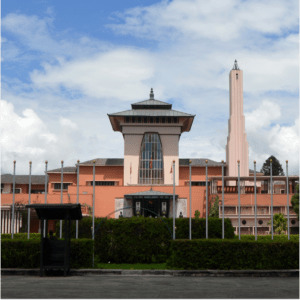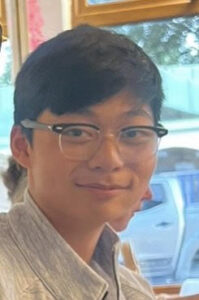Students from Harbingers’ Nepali Newsroom share their experiences after a recent visit to this royal museum

Narayanhiti Palace turned into a public museum in 2006.
July 16, 2024
Reasons to visit the Narayanhiti Palace Museum in Nepal
Narayanhiti Palace is a former royal residence that was turned into a museum after the monarchy was overthrown in Nepal and the country was declared a federal democratic republic. It was designed for kings, but now it is open to everyone.
The palace is located at Durbar Marg in Kathmandu, closer to Kaiser Mahal, another palace complex, and next to the nightlife zone of Thamel. It was converted into a museum in 2008 and officially opened to the public in 2009.
Built between 1963 and 1969, the palace was designed by US architect Benjamin Polk, who worked mainly in India and Nepal.
We found six interesting things about the palace that everyone must know.
1. Five famous monarchs
These are the best known rulers of Nepal’s many kings.
Prithivi Narayan Shah was the first king of modern Nepal, ruling from 1743–1768. He unified the small kingdom into one nation, all of Nepal.
Tribhuvan Bir Bikram Shah ruled from 1911–1955 and played a pivotal role in ending the Rana regime. The authoritarian Rana family controlled the country as prime ministers from 1846 to 1951, reducing the monarch to a figurehead.
Birendra Bir Birkam Shah ruled from 1972–2001 and oversaw the transition to a constitutional monarchy in 1990.
Dipendra Bir Bikram Shah was king for just three days in 2001, while in a coma after the infamous royal massacre. He had tried to commit suicide after killing members of his own family.
Gyanendra Bir Bikram Shah was king twice, for a couple months at age three between 1950–1951 and again from 2001 (after the royal massacre) to 2008. His second reign ended when the monarchy was abolished and Nepal became a federal democratic republic.
2. The royal massacre
On June 1, 2001, a massacre happened inside Narayanhiti Palace, in which nine members of the royal family, including King Birendra and Queen Aishwayra, were killed on the same day. The event shocked and saddened the entire country and also began the downfall of monarchy in Nepal.
It is one of the biggest suspense murders in the history of Nepal. It is said that Prince Dipendra murdered almost all his family members and then attempted suicide. However, many disagree with this, and politicians in Nepal still use this as a weapon to suppress dissenting voices.
On that Friday night there was a huge party inside the palace in which every family member was invited. Afterwards, Prince Dipendra, who was in a coma, was automatically declared king, but three days later he was also declared dead.
After the incident, the whole country was in mourning. The public could not believe it. Birendra’s unpopular brother, Gyanendra, became king and ruled until the monarchy was abolished. Currently, he is living a normal life but he has close ties with the Rastriya Prajatantra Party (RPP), whose chief ideology is to restore the monarchy.
3. Shree Sadan
Shree Sadan is the former private residence of the late King Birendra in the grounds of the palace. Designed by King Birendra himself, it first opened to the public on November 22, 2020.
It follows a simple three-storey design incorporating Chinese and Nepali multi-roof temple styles. There are twelve rooms, including the bedrooms of the king, queen, crown prince, princess and little prince, plus the private office of the king, an exercise room and a tea room. There are also several pictures and drawings hanging on the wall, made by princesses and other famous artists. There were also many antique materials, such as imported liquor bottles, purchased by the royal family.
The management of the Shree Sadan is taken care of by the government, and staff employed there keep it neat and clean for visitors.
4. Royal crown (Sripech)
The sripech (which means crown) was traditionally worn by Nepali monarchs. On view in the last room of the palace, it contains 730 diamonds and 2,000 pearls. It is studded with precious rubies as well. The top of the crown contains feathers from a bird of paradise, which is associated with majesty, authority and sovereignty. Former Prime Minister Chandra Shumsher brought the feather from the US in order to make the crown more attractive.
The design of the crown is unique and reflects Nepalese culture and religion. A grand ceremony was organised by former Prime Minister KP Sharma Oli to install the crown for public view. It looked so beautiful.
5. King’s and Queen’s garments
The clothing worn by Nepalese kings and queens reflects the rich cultural heritage and royal tradition of the country.
The daura suruwal is worn by males in Nepal. The daura is worn over the upper half of the body as a tunic. It is made up of eight pattern blocks and has four ties – two above the chest near the shoulders and two near the waist. Suruwal (which means pyjama in Nepali) are trousers. The traditional Nepali hat is the topi.
Prime Minister Bir Shamsher Rana declared the daura suruwal to be the national dress and ordered all Nepali people to wear it on formal occasions. Until that time, it is said, commoners were restricted from wearing suruwal in order to keep class distinctions.
After the fall of the Rana regime, King Tribhuvan continued the tradition of wearing the combination of daura suruwal, topi and coat. In 1960, King Mahendra, under his nationalism movement, made the daura suruwal mandatory for all civil servants.
The traditional clothing for Nepali women, including the queen, is the gunyo cholo. It consists of a long-sleeved blouse and wrap-around skirt, and is often made of lush fabrics and designs. The queen also wore a sari, a long piece of fabric wrapped around the body and draped elegantly over one shoulder.
Nepalese jewellers made necklaces, earrings, rings, bracelets and other ornaments for the king and queen. These are made of gold, silver and gems. Both kings and queens wore traditional Nepalese footwear, such as leather sandals or shoes known as sooters or chappals.
6. Royal vehicles
There are a collection of cars inside Narayanhiti Durbar. All are old-fashioned and bulletproof. They include a 1939 Mercedes-Benz, a gift from Adolf Hitler to King Tribhuvan. After his death, the car was used for study in engineering colleges.
A Rolls Royce Silver Cloud III was gifted by Britain’s Queen Elizabeth II to King Mahendra in 2017, when she came to visit Nepal. Now this car is kept in the Military Museum.
Queen Elizabeth II gave the Gold State Coach to King Mahendra Shah during her first state visit to Nepal in 1961. It was first used on February 24, 1975, for King Birendra Shah’s coronation. It is made of wood and gold. A horse-drawn chariot (Baggi), another gift from Queen Elizabeth II, was inaugurated for display to the public in September 2021.
The royal family also had different kinds of air transport, used when they visited foreign countries. An aeroplane and a helicopter are still kept at the museum for public visits.




